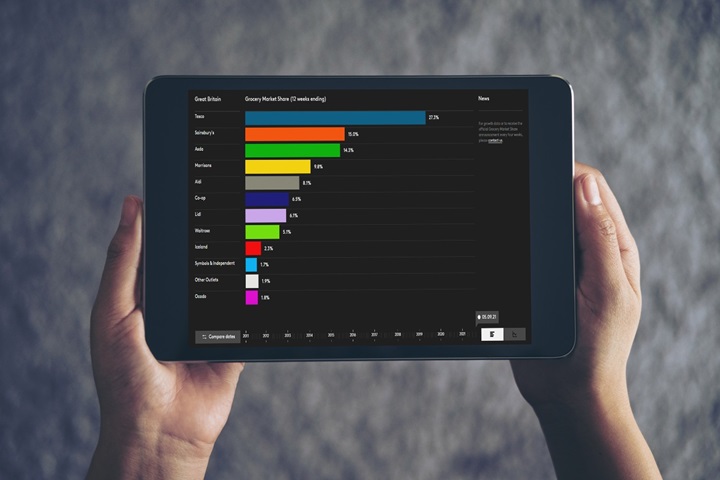The latest grocery market share figures from Kantar show take-home sales rose by 9.3% during the 12 weeks to 1 November 2020. Despite a variety of restrictions coming into force across the country, there was no significant spike in demand in the most recent four weeks, as sales increased by a similar 9.4%.
Growth rates peaked in Wales, where restrictions were tightest, up by 15% in the month to 1 November. Welsh shoppers increased their spending by an average of £10 during the week when the ‘firebreak’ lockdown came into effect. The following week, online shopping in Wales hit its highest ever level, accounting for 16.2% of the market. In Britain as a whole, a record 5.9 million people purchased groceries online in the month of October.
Early evidence suggests that consumers in England are confident about getting the essentials during the new lockdown – which started on 5 November – even if the restrictions impinge on festive shopping. While there was some uplift in Wales, the increased spending did not provide any evidence of stockpiling, and initial figures suggest no sign of panic buying in England either. But one thing is always front of mind at this time of year – Christmas – and it seems many people sought to get ahead with gift buying before stores closed. Between Monday and Wednesday last week, the three days before additional nationwide restrictions were introduced in England, toy and entertainment stores took more than double their share of pre-COVID-19 footfall*, and shoppers rushed to gift shops and fashion retailers.
The prospect of spending less time out and about during winter means people are hunkering down with seasonal comforts and making the best of life at home. Sales of scented candles, pot pourri and essential oils for diffusers have grown by 29% compared with last year.
Meanwhile, premium own label products are up by £56 million this month. The category consistently hits its peak in December, so this could be an early indication of more to come as we approach what is likely to be an unusual Christmas. Halloween was different this year as well, with shoppers celebrating at home, rather than on the streets. The same amount was spent on pumpkins as in 2019 – £9 million – but sales of sugar sweets were 2.3% lower in October as trick or treating was put on hold.
Frozen food has been a hot ticket since the beginning of the pandemic, and sales have risen by 14% in the latest 12 weeks. That follows a spike in sales of fridge freezers over the summer**, showing the desire for long-lasting provisions in the current climate. Iceland has benefited the most from the trend, helping to grow its market share to 2.3%, from 2.1% last year. Overall, the retailer’s sales were up by 17.9%, and shoppers didn’t stop at the freezer section. More was spent in Iceland’s chilled and ambient aisles as well, meaning the average spend per trip was worth 44% more than in 2019, the greatest increase of any retailer.
Ocado was again the fastest growing retailer, with sales up by 36.1%, increasing its market share to 1.7%. Waitrose meanwhile grew ahead of the market, by 10.6%, and its share rose for the first time since 2017 to 5.1%. Waitrose increased its online sales faster than any other grocer this period.
Morrisons led the big four, growing sales by 11.4%, and expanding its share for the fifth month in a row. It now accounts for 10.2% of sales, helped by its The Best premium own label brand, which grew by 42%. Sainsbury’s sales rose by 7.6% this period and its market share currently sits at 15.3%. The retailer recently announced it would permanently close its fresh food counters, a move which reflects a market-wide drop off in the number of people using in-store butchers, delis, and fishmongers.
The number of supermarket trips involving a visit to the delicatessen, meat, or fish counter has fallen by 33% in the past 12 weeks, with many operations suspended because of the pandemic. But that doesn’t mean shoppers are snubbing unpackaged, fresh products altogether. In fact, the first national lockdown saw record numbers of people buy meat from other sources. Over two million households have visited their local butcher in the past three months, 100,000 more than this time last year.
Asda increased sales by 5.0% this period and it holds a market share of 14.4%. Tesco, which grew by 9.1%, maintained its share at 27.0% and had success through both physical and online sales. Lidl’s growth accelerated to 12.5%, with market share up to 6.1%, while Aldi’s sales rose by 6.6%, and its share fell slightly to 7.8%. Co-op increased sales by 8.6%, but its market share dipped to 6.4%, while independent retailers accounted for 1.9% of the market, as sales grew by 15.6%.
Notes
* Findings based on Worldpanel Plus, Kantar’s panel of 80,000+ British shoppers recording all retail purchasing in all retailers. Daily footfall share index Monday 2 to Wednesday 4 November vs pre-March.
** Findings based on Worldpanel Plus, sales of fridge/freezers in physical stores, 52 weeks to 6 September 2020.


